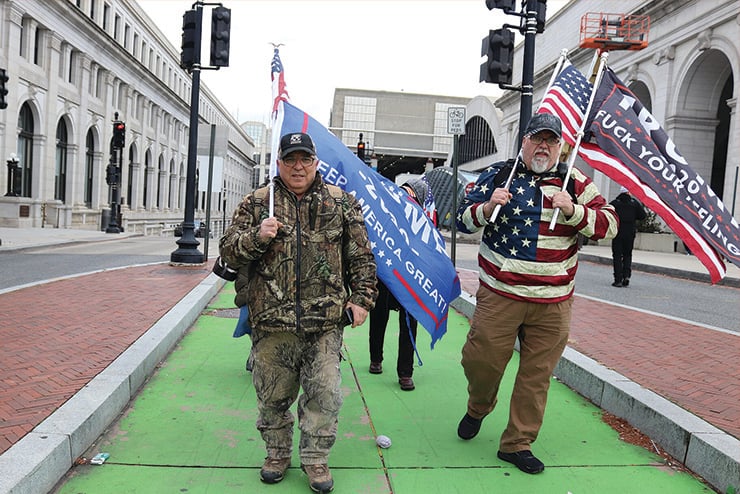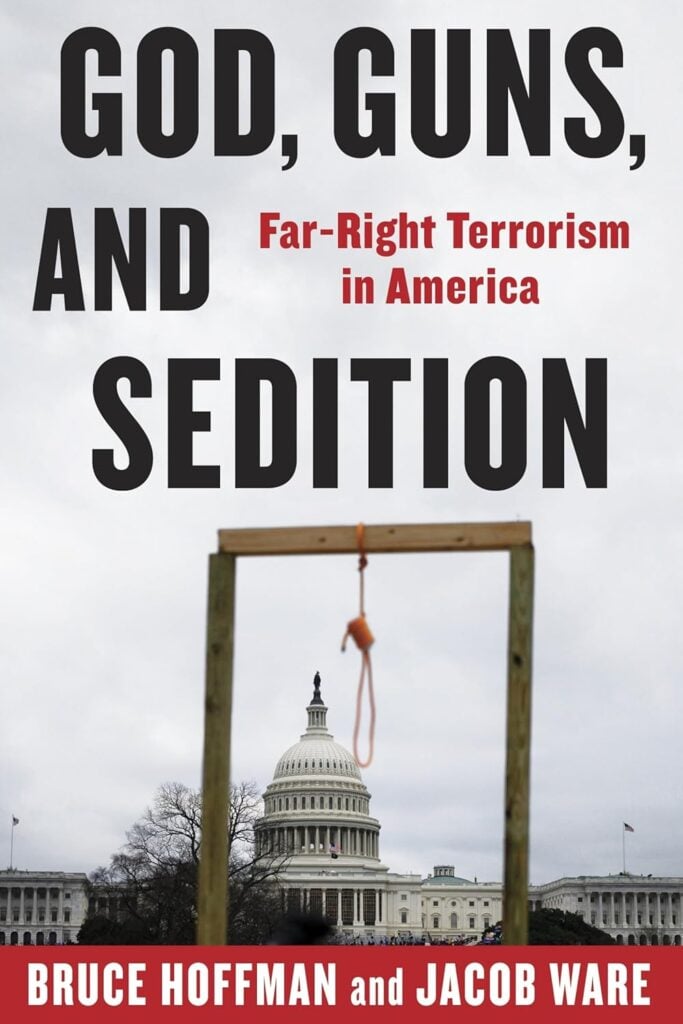God, Guns, and Sedition: Far Right Terrorism in America
by Bruce Hoffman and Jacob Ware
Columbia University Press
448 pp., $22.95
Here is a reasonably accurate method for guessing the likelihood that a given individual teaches in an institution of higher education. Just ask him which is the more devastating and reprehensible act of anti-American terror: Sept. 11 or Jan. 6?
It is getting increasingly difficult to distinguish the current wave of academic hand-wringing over the indigenous “right-wing terror threat”—allegedly represented by the Jan. 6 riot—from parody. Despite all the evidence showing that the riot was a one-off, the starting premise of all such research is that it’s a trend. It was not an unfortunate but spontaneous and emotional reaction by a comparative handful of overexcited people to an election process that any objective observer would classify as abnormal. On the contrary, it was a world-changing monstrosity, the worst assault on “our democracy” of all time, and the outcome of long-term planning by the enemies of America.
Adherents to this view are immune to the nontrivial fact that the FBI found precious little evidence showing coordination surrounding the events on that day. Rational people might well wonder, for example, whether “terrorist” is an apt term for people such as Rachel Powell. She is a mother of eight who was sentenced to five years in prison for breaking a window at the Capitol and yelling into a bullhorn.
Experts such as Bruce Hoffman and Jacob Ware are certain Rachel Powell must be recognized as holding a place in a sinister line of white supremacist terrorists who have been planning the overthrow of America dating back at least to the 1980s. And, such scholars breathlessly inform us, this nefarious movement is still hard at work on the project of destroying everything we hold dear. Fortunately for us, these courageous authors have given us a book, God, Guns, and Sedition, to help us understand and combat this threat.
Yet the authors confidently assert many claims that run afoul of reality. They impute a huge role on Jan. 6 to the “boogaloo movement,” which they describe as a coherent element of the far right. But according to the Center for Strategic and International Studies (CSIS), the boogaloo movement cannot be so simply classified in political terms. The CSIS report describes considerable practical cooperation between boogalooers and Black Lives Matter protesters, and ideological agreement with BLM claims about police brutality. Hoffman and Ware also insist that the Jan. 6 rioters targeted members of Congress for assassination. But even the Biden administration Department of Justice is on record denying this.
Hoffman and Ware are mortified that many Americans believe “violence against their government could be justified in certain circumstances.” Our founders would have had little difficulty postulating some circumstances that might cross this threshold. Perhaps our authors are familiar with these words of Thomas Jefferson, writing to John Adams’s son-in-law:
[W]hat country can preserve its liberties if their rulers are not warned from time to time that their people preserve the spirit of resistance? Let them take arms… The tree of liberty must be refreshed from time to time with the blood of patriots and tyrants. It is its natural manure.
Hoffman and Ware do not mention Jefferson’s statement, but their ninth chapter begins with the following quotation as an illustration of the kind of proto-terrorist thinking they target in the book: “Freedom is a fragile thing and … it must be fought for.” The speaker of the phrase in question, of course, was that famous radical, Ronald Reagan.
The authors claim that there are perhaps 100,000 Americans “actively involved with white supremacist extremist groups.” But what counts as active involvement? They do not say. Recall, too, that this figure is the total within a country of more than 325 million souls. If their figure is accurate, that means that of every 3,250 Americans, fully 3,249 are not “actively involved with white supremacist groups.”
The authors acknowledge that the government could not use the same kinds of tactics against these individuals that it does against international Islamist groups. So, their most avidly radical left readers will be disheartened to learn Hoffman and Ware do not advocate targeted assassination by drones of people who adhere to the ideas of Jefferson and Reagan. Yet they do argue that a broad strategy of immediate action against this threat is necessary.
For example, they deplore the “social media titans” who, in their view, have not done enough to “intervene” against “dangerous actors” exploiting their platforms. Fears about the demographically transformative effects of American immigration are freely expressed in such media, and this is a bad thing. In order to prevent such ideas from proliferating, the authors suggest that these media must do much more in the way of gathering “intelligence” on users to assist efforts identifying potential extremists to prosecute. They approvingly point to more draconian European restrictions on speech and suggest something similar should be implemented here. Doubtless, they complain, “the stringent free speech laws made sacred … by the First Amendment” will get in the way of this plan, but this is not an insuperable barrier.
Social media companies must become fully legally liable for what people say on their platforms. This will involve collaboration of executive, judicial, and legislative branches of the federal government to “collectively reform Section 230, the Title 47 provision that protects social media companies from being held legally liable for material posted on their platforms.” “Authoritarian states” must not have undue influence there and must be prevented from “undermin[ing] core Western democratic values.” In our authors’ definition, those core Western values apparently do not include freedom of speech.
Hoffman and Ware also advocate for criminalizing the activity of any personnel in the U.S. military or law enforcement “espousing and adhering to violent extremism.” Practically, that means any soldier or police officer who offers the slightest sympathy for the treatment of the Jan. 6 defendants is potentially guilty here. The authors are enthusiastic about the fact that the Defense Department can now bring disciplinary action to bear on military personnel for merely “liking” the wrong social media post.
Indeed, the entire society must be mobilized to eliminate impure thinking. Government must “encourage[e] both the private and nonprofit sectors to build strong programs [attacking right-wing ideology], along with metrics that can measure the programs’ successes and failures.” National media literacy programs will need to be established to teach Americans how to distinguish fake news from the real thing and to teach us to rely only on “accurate and reliable sources.” Social studies curricula could also be mobilized in this effort to teach benighted Americans how to know the real experts from the right-wing extremists.
It is not only the flow of ideas these authors dislike. Further restrictions on the legal means for obtaining firearms would, they assure us, cut massively into right-wing terrorism. But if these are terrorists, can they not just avail themselves of the thriving criminal market in illegal weapons? This is an eternal problem facing adherents to militant anti-Second Amendment ideology.
There is a vast industry in literature and research on “the white supremacist movement” amidst which this book takes its place. One of its main non-academic arms is the Southern Poverty Law Center. In American universities, there are many scholars who base their entire careers on this subject. They include the University of Chicago’s Kathleen Belew and American University’s Cynthia Miller-Idriss. These blowhards can count on academic publishing institutions and a mainstream media that will eagerly pass along their message, without the slightest bit of critical attention to the specific claims they make.
During the time I was writing this review, an illustrative example appeared. Mainstream news outlets excitedly announced that California arrested some 68 members of an Aryan Brotherhood offshoot gang called “Peckerwoods.” The media sources typically accompanied their reporting on police discovery of fentanyl and Hitler paraphernalia while exulting attacks on Donald Trump. Why? Well, because Trump has hatefully discussed the subject of crimes committed by illegal immigrant gangs as though it were a serious problem.
Meanwhile, days before the Peckerwoods story was treated to generous national coverage, San Antonio local news discussed a massive police action in an apartment complex to respond to reports of illegal drug commerce, human trafficking, and threats to apartment staff. Nineteen suspects were detained. Nearly all of them were illegal immigrants and several have known affiliations to the Venezuelan criminal gang Tren de Aragua. I tried unsuccessfully to find any mention of the San Antonio story on CNN, MSNBC, and a host of the other left-leaning national news sites.
Unmentioned in any of the stories on the Peckerwoods, of course, is the fact that black criminal gangs have a much wider footprint on the violent crime map of the United States than the odd white supremacist gang. From the start of the Crips-Bloods war in the 1970s until 2014, somewhere around 20,000 murders were carried out under its aegis. Good luck trying to find national mainstream media stories on this death toll that are as lovingly focused on the details as the triumphal Peckerwoods coverage.
This is the alternate reality writers such as Hoffman and Ware have helped to produce.


Leave a Reply